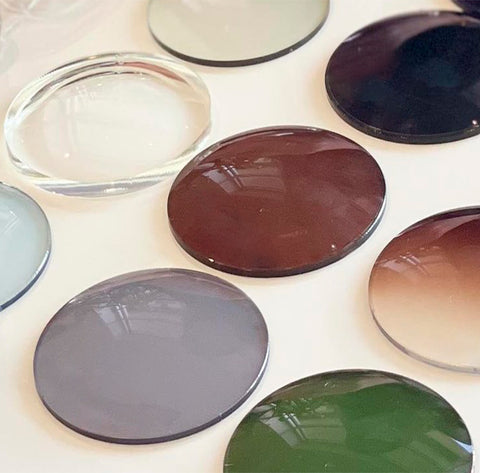Eyeglasses Lenses And Coatings
When it comes to choosing the perfect pair of eyeglasses, there are many factors to consider. One of the most important aspects of eyeglasses is the lenses and coatings. The lenses are the part of the glasses that actually correct your vision, and the coatings are additional layers that can enhance the performance and longevity of the lenses.
In this article we will discuss the different types of lenses and coatings available, and how to choose the best options for your needs.

Types of Lenses
There are several different types of lenses available for eyeglasses, each with its own unique benefits and drawbacks. The most common types of lenses include:
1. Single Vision Lenses: These lenses are designed to correct one type of vision problem, such as nearsightedness or farsightedness.
2. Bifocal Lenses: Bifocal lenses have two distinct areas with different prescriptions, usually for near and distance vision.
3. Trifocal Lenses: Trifocal lenses have three distinct areas with different prescriptions, for near, intermediate, and distance vision.
4. Progressive Lenses: Progressive lenses are similar to bifocals and trifocals, but they have a seamless transition between the different prescription areas, providing a more natural and comfortable vision correction.
In addition to these basic types of lenses, there are also specialized lenses available for specific needs, such as for computer use, sports, or safety glasses.
Lens Materials
Lenses can be made from a variety of materials, each with its own unique properties. The most common lens materials include:
1. Glass: Glass lenses are durable and scratch-resistant, but they are also heavy and can shatter if dropped.
2. Plastic: Plastic lenses are lightweight and impact-resistant, making them a popular choice for many people.
3. Polycarbonate: Polycarbonate lenses are even more impact-resistant than plastic lenses, making them a great choice for sports and safety glasses.
4. High-Index: High-index lenses are thinner and lighter than traditional plastic lenses, making them a great choice for people with higher prescriptions.
Lens Coatings
In addition to the type of lens material and design, there are also several different coatings available that can enhance the performance and durability of the lenses. Some of the most common lens coatings include:
1. Anti-Reflective Coating: This coating reduces glare and reflections on the lenses, improving vision and making the lenses more cosmetically appealing.
2. Scratch-Resistant Coating: This coating helps protect the lenses from scratches, prolonging their lifespan and keeping them looking new.
3. UV Protection: Some lenses come with built-in UV protection to block harmful UV rays from the sun, helping to protect your eyes from damage.
4. Blue Light Protection: With the increasing use of digital devices, blue light protection coatings are becoming more popular to reduce eye strain and potential damage from prolonged exposure to blue light.
Choosing the Right Lenses and Coatings
When choosing the right lenses and coatings for your eyeglasses, it's important to consider your individual needs and lifestyle. If you spend a lot of time outdoors, for example, you may want to prioritize UV protection and scratch resistance. If you work on a computer all day, blue light protection and anti-reflective coatings may be more important to you.
It's also important to consider your prescription and the type of frames you will be using. Some lens materials may be too thick or heavy for certain frames, and some coatings may not be compatible with certain materials.
The lenses and coatings of your eyeglasses play a crucial role in your vision correction and overall comfort. By understanding the different types of lenses and coatings available, and considering your individual needs and lifestyle, you can make an informed decision when choosing the perfect pair of eyeglasses. Be sure to consult with your eye care professional to determine the best options for your specific needs.
In this article we will discuss the different types of lenses and coatings available, and how to choose the best options for your needs.

Types of Lenses
There are several different types of lenses available for eyeglasses, each with its own unique benefits and drawbacks. The most common types of lenses include:
1. Single Vision Lenses: These lenses are designed to correct one type of vision problem, such as nearsightedness or farsightedness.
2. Bifocal Lenses: Bifocal lenses have two distinct areas with different prescriptions, usually for near and distance vision.
3. Trifocal Lenses: Trifocal lenses have three distinct areas with different prescriptions, for near, intermediate, and distance vision.
4. Progressive Lenses: Progressive lenses are similar to bifocals and trifocals, but they have a seamless transition between the different prescription areas, providing a more natural and comfortable vision correction.
In addition to these basic types of lenses, there are also specialized lenses available for specific needs, such as for computer use, sports, or safety glasses.
Lens Materials
Lenses can be made from a variety of materials, each with its own unique properties. The most common lens materials include:
1. Glass: Glass lenses are durable and scratch-resistant, but they are also heavy and can shatter if dropped.
2. Plastic: Plastic lenses are lightweight and impact-resistant, making them a popular choice for many people.
3. Polycarbonate: Polycarbonate lenses are even more impact-resistant than plastic lenses, making them a great choice for sports and safety glasses.
4. High-Index: High-index lenses are thinner and lighter than traditional plastic lenses, making them a great choice for people with higher prescriptions.
Lens Coatings
In addition to the type of lens material and design, there are also several different coatings available that can enhance the performance and durability of the lenses. Some of the most common lens coatings include:
1. Anti-Reflective Coating: This coating reduces glare and reflections on the lenses, improving vision and making the lenses more cosmetically appealing.
2. Scratch-Resistant Coating: This coating helps protect the lenses from scratches, prolonging their lifespan and keeping them looking new.
3. UV Protection: Some lenses come with built-in UV protection to block harmful UV rays from the sun, helping to protect your eyes from damage.
4. Blue Light Protection: With the increasing use of digital devices, blue light protection coatings are becoming more popular to reduce eye strain and potential damage from prolonged exposure to blue light.
Choosing the Right Lenses and Coatings
When choosing the right lenses and coatings for your eyeglasses, it's important to consider your individual needs and lifestyle. If you spend a lot of time outdoors, for example, you may want to prioritize UV protection and scratch resistance. If you work on a computer all day, blue light protection and anti-reflective coatings may be more important to you.
It's also important to consider your prescription and the type of frames you will be using. Some lens materials may be too thick or heavy for certain frames, and some coatings may not be compatible with certain materials.
The lenses and coatings of your eyeglasses play a crucial role in your vision correction and overall comfort. By understanding the different types of lenses and coatings available, and considering your individual needs and lifestyle, you can make an informed decision when choosing the perfect pair of eyeglasses. Be sure to consult with your eye care professional to determine the best options for your specific needs.






